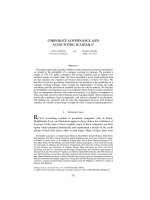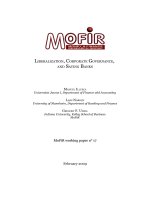Reading 27 introduction to corporate governance and other ESG considerations answers
Bạn đang xem bản rút gọn của tài liệu. Xem và tải ngay bản đầy đủ của tài liệu tại đây (200.93 KB, 13 trang )
Question #1 of 26
Question ID: 1378633
Risks that may arise from ineffective corporate governance least likely include:
A) reduced default risk.
B) less effective decision making.
C) weaker financial performance.
Explanation
Ineffective corporate governance is likely to increase default risk.
(Study Session 9, Module 27.2, LOS 27.h)
Question #2 of 26
Question ID: 1378635
Which of the following factors should an analyst most likely consider favorable for
shareholders' interests?
A) Anti-takeover provisions.
B) Dual-class share structures.
C) Non-executive directors.
Explanation
Non-executive, or external, directors are typically viewed as more likely to act in
shareholders' interests than executive, or internal, directors. Dual-class structures may
allow a small group of shareholders, such as company founders and their heirs, to
exercise control disproportionate to their ownership stake. Anti-takeover provisions limit
shareholders' ability to bring about changes in management.
For Further Reference:
(Study Session 9, Module 27.2, LOS 27.i)
CFA® Program Curriculum, Volume 3, page 626
Question #3 of 26
Question ID: 1378618
The stakeholders most likely to be concerned with their legal liabilities are:
A) regulators.
B) creditors.
C) directors.
Explanation
Directors are legally responsible for their decisions and actions as board members.
Neither regulators nor creditors face significant legal liabilities for their actions.
(Study Session 9, Module 27.1, LOS 27.b)
Question #4 of 26
Question ID: 1378620
The stakeholder group that typically prefers the greatest amount of business risk is:
A) directors.
B) shareholders.
C) senior managers.
Explanation
Compared to the other two groups, shareholders have the greatest potential gains from
riskier strategies and can diversify their holdings across firms in order to reduce the
influence of company specific risk. While senior managers can gain from company
outperformance, they typically prefer less risk than shareholders because managers' risk
of poor company performance on the value of their options and on their careers cannot
be easily diversified away.
(Study Session 9, Module 27.1, LOS 27.b)
Question #5 of 26
Question ID: 1383112
Environmental, social, and governance (ESG) investing is most accurately described as:
A)
investing only in companies that promote environmental or social initiatives
favored by an investor.
B)
C)
integrating environmental and social considerations into the investment
decision making process.
excluding companies from consideration for investment based on
environmental or social considerations.
Explanation
ESG investing is using environmental, social, and governance factors when making
investment decisions. Investing only in companies that promote environmental or social
initiatives favored by an investor is best described as impact investing. Excluding
companies from consideration for investment based on environmental or social
considerations is best described as negative screening. Impact investing and negative
screening are two of the approaches an investor can use to implement ESG investing.
(Study Session 9, Module 27.2, LOS 27.j)
Question #6 of 26
Question ID: 1378621
The relationship between a company's shareholders and its senior managers is best
described as a(n):
A) agency relationship.
B) working partnership.
C) principal relationship.
Explanation
This is an example of an agency relationship, which is also known as a principal-agent
relationship. A company's senior managers are acting as agents, hired to act in the interest
of shareholders who are the principal in the relationship.
(Study Session 9, Module 27.1, LOS 27.c)
Question #7 of 26
Question ID: 1383109
Minority shareholder groups are most likely to have influence over corporate strategy when
board elections are:
A) staggered and use cumulative voting.
B) annual and use cumulative voting.
C) staggered and use majority voting.
Explanation
With cumulative voting, minority shareholders are more likely to gain seats on the board
of directors and influence corporate strategy and decisions than with majority voting.
Compared to annual elections for all board seats, staggered board elections limit the
ability of shareholders to select an entirely new board, except over a period of years.
(Study Session 9, Module 27.1, LOS 27.e)
Question #8 of 26
Question ID: 1383111
Analysis of a firm's remuneration is most likely to inform an analyst as to:
A) whether management’s incentives align with the firm’s objectives.
B) potential conflicts of interest arising from the firm’s cross-shareholdings.
C) the voting rights of shareholders who hold different share classes.
Explanation
Disclosures of a firm's remuneration programs enable an analyst to judge whether its
compensation structure aligns management's incentives with the firm's objectives and
shareholders' interests.
(Study Session 9, Module 27.2, LOS 27.i)
Question #9 of 26
Question ID: 1378614
Which of the following statements about corporate governance is most accurate? Corporate
governance:
A) is defined in the same way in most countries.
B) may be focused only on shareholder interests.
C) best practices are essentially the same in developed economies.
Explanation
Under the shareholder theory of corporate governance, practices are primarily those that
support shareholder interests, while under the stakeholder theory of corporate
governance, the interests of various affected groups are considered and balanced.
Corporate governance practices and definitions vary across countries.
(Study Session 9, Module 27.1, LOS 27.a)
Question #10 of 26
Question ID: 1378632
With regard to a corporation's legal environment, the interests of shareholders and firm
creditors are typically best served by:
A) a civil law system.
B) a common-law system.
C) an enacted statute system.
Explanation
Shareholder and creditor interests are considered to be better protected in a common-law
system under which judges' rulings become law in some instances.
For Further Reference:
(Study Session 9, Module 27.2, LOS 27.g)
CFA® Program Curriculum, Volume 3, page 620
Question #11 of 26
Question ID: 1378623
In the context of stakeholder management, organizational infrastructure is most accurately
described as:
A) a framework for defining the rights and responsibilities of stakeholders.
B) contractual arrangements a company enters into with its stakeholders.
C) a company’s internal procedures for addressing stakeholder relationships.
Explanation
Organizational infrastructure refers to the practices and governance procedures that a
company adopts to manage its stakeholder relationships.
(Study Session 9, Module 27.1, LOS 27.d)
Question #12 of 26
Question ID: 1383108
The stakeholders of a company that are least likely to prefer a relatively riskier company
strategy that has the potential for superior company performance are:
A) creditors.
B) suppliers.
C) shareholders.
Explanation
A company's creditors prefer less risk because their potential gains from superior
company performance are limited, while they have significant downside risk from poor
performance that could threaten the company's solvency. Shareholders have the greatest
gains from superior company performance. Suppliers may benefit from superior
performance of a company to which they supply goods and services, but in general they
prefer stable business operations and continuation of their business relationship with the
company.
(Study Session 9, Module 27.1, LOS 27.b)
Question #13 of 26
Question ID: 1378638
With regard to environmental, social, and governance (ESG) considerations, which of the
following statements is most accurate?
A)
B)
C)
Fiduciary duty requires managers to integrate their clients’ ESG-related
considerations into investment decisions.
Integrating ESG factors into the analysis of a company’s risk and return
characteristics is not considered a violation of fiduciary duty.
A “values-based” objective involves investing in companies that have ESGrelated opportunities that are not fully reflected in their share prices.
Explanation
Using ESG factors in estimating the risk and returns of a company is not considered a
violation of a manager's fiduciary duty to clients and beneficiaries. ESG considerations
may conflict with fiduciary duty if they result in the manager accepting lower returns or
higher risk than they otherwise would. A "values-based" investment objective is to express
the investor's ethical beliefs through investment decisions. A "value-based" approach to
ESG investing refers to considering ESG-related risks and opportunities alongside
traditional investment considerations.
For Further Reference:
(Study Session 9, Module 27.2, LOS 27.j)
CFA® Program Curriculum, Volume 3, page 632
Question #14 of 26
Question ID: 1378622
A principal-agent relationship most likely exists between a company's:
A) directors and regulators.
B) shareholders and managers.
C) customers and suppliers.
Explanation
The relationship between shareholders and managers is a principal-agent relationship.
Shareholders, as principals, through the board of directors hire managers, as agents, to
act in the best interests of the shareholders.
(Study Session 9, Module 27.1, LOS 27.c)
Question #15 of 26
Question ID: 1378628
With a one-tier board structure:
A) senior managers determine corporate strategy.
B) independent directors determine company strategy.
C) both executives and non-executives can serve on the board of directors.
Explanation
Independent directors and senior managers both serve on a single board with a one-tier
board structure and are jointly responsible for determining corporate strategy.
(Study Session 9, Module 27.1, LOS 27.f)
Question #16 of 26
Question ID: 1378629
A company director's duty of loyalty is most accurately described as requiring a director to:
A) perform his or her duties in good faith and with due diligence.
B) carry out the duties assigned by the managers of the company.
C) act in the interests of the company and its shareholders.
Explanation
The duty of loyalty requires a company director to act in the interests of the company and
its shareholders. The board of directors is responsible for appointing the company's
managers; the managers do not assign duties to board members.
(Study Session 9, Module 27.1, LOS 27.f)
Question #17 of 26
Question ID: 1383110
Smith Company's board of directors assigns responsibilities to several committees. The
committee that is most likely to be responsible for establishing the chief executive officer's
compensation package is Smith's:
A) risk committee.
B) remuneration committee.
C) governance committee.
Explanation
Compensation for a company's senior executives is typically a responsibility of a
remuneration or compensation committee.
(Study Session 9, Module 27.1, LOS 27.f)
Q
i
#18 f 26
Question #18 of 26
Question ID: 1378619
Which of the following stakeholders are most likely to benefit from a company's growth and
excellent financial performance?
A) Creditors.
B) Customers.
C) Governments.
Explanation
Governments receive greater tax revenues when financial performance is excellent and
profits are higher. Creditors do not receive extra returns for performance better than that
is adequate to repay debt. Customers seek company stability and ongoing relationships
with the company.
(Study Session 9, Module 27.1, LOS 27.b)
Question #19 of 26
Question ID: 1378616
The interests of community groups affected by a company's operations are most likely to be
considered in corporate governance under:
A) special interest theory.
B) shareholder theory.
C) stakeholder theory.
Explanation
Community groups may be one of the stakeholder groups considered under stakeholder
theory.
(Study Session 9, Module 27.1, LOS 27.a)
Question #20 of 26
Question ID: 1378625
A conflict of interest between corporate stakeholders is least likely to be mitigated by:
A) issuing stock dividends.
B) covenants in debt indentures.
C) including stock options as part of manager compensation.
Explanation
Issuing stock dividends does not necessarily favor one group of stakeholders over another
because neither firm value nor earnings are affected by issuing a stock dividend.
Covenants in debt issues protect creditor interests from management actions that would
increase the risk of the debt. Including stock options as part of manager compensation
serves to align the interests of senior management and shareholders.
(Study Session 9, Module 27.1, LOS 27.e)
Question #21 of 26
Question ID: 1380835
Responsibilities of a board of directors' nominations committee are least likely to include:
A) selecting an external auditor for the company.
B) recruiting qualified members to the board.
C) evaluating the independence of directors.
Explanation
Selecting an external auditor (subject to shareholder approval) is a responsibility of the
Board's audit committee.
For Further Reference:
(Study Session 9, Module 27.1, LOS 27.f)
CFA® Program Curriculum, Volume 3, page 615
Question #22 of 26
Question ID: 1378626
A company's internal systems and practices for managing stakeholder relationships are
most accurately described as its:
A) organizational infrastructure.
B) contractual infrastructure.
C) governance infrastructure.
Explanation
Organizational infrastructure is a company's corporate governance procedures and
internal systems and practices for managing stakeholder relationships.
(Study Session 9, Module 27.1, LOS 27.e)
Question #23 of 26
Question ID: 1378627
Special resolutions that require a supermajority of shareholder votes may be addressed:
A) only at the annual general meeting.
B) only at an extraordinary general meeting.
C) at either the annual general meeting or an extraordinary general meeting.
Explanation
Special resolutions may be voted on at the annual general meeting or at an extraordinary
general meeting that is called specifically to address them.
For Further Reference:
(Study Session 9, Module 27.1, LOS 27.e)
CFA® Program Curriculum, Volume 3, page 608
Question #24 of 26
Question ID: 1378636
In the absence of any ESG-related constraints specified in an investment policy statement, a
portfolio manager is most likely to violate fiduciary duty by using ESG factors to:
A) assess the expected return and risk of potential portfolio investments.
B)
exclude investments with negative ESG characteristics from the investor’s
portfolio.
C) choose among investments with similar risk and return characteristics.
Explanation
Constructing a portfolio based on ESG factors may violate fiduciary duty if doing so
reduces expected returns. Analyzing ESG factors when assessing investment risk or using
ESG factors to choose among otherwise equivalent investments would likely not violate
fiduciary duty.
(Study Session 9, Module 27.2, LOS 27.j)
Question #25 of 26
Question ID: 1378615
The stakeholder theory of corporate governance is primarily focused on:
A) increasing the value a company.
B) the interests of various stakeholders rather than the interests of shareholders.
C)
resolving the competing interests of those who manage companies and other
groups affected by a company’s actions.
Explanation
Resolving the conflicting interests of both shareholders and other stakeholders is the
focus of corporate governance under stakeholder theory. Shareholders are among the
groups whose interests are considered under stakeholder theory.
(Study Session 9, Module 27.1, LOS 27.a)
Question #26 of 26
Question ID: 1378639
Thematic investing is most accurately described as:
A)
identifying the best companies in each sector with respect to environmental
and social factors.
B) considering a single environmental or social factor when selecting investments.
C)
excluding companies or sectors from consideration for investment based on
environmental and social factors.
Explanation
Thematic investing refers to selecting investments with a view to a specific environmental,
social, or governance factor. Identifying the best companies in each sector with respect to
environmental and social factors is referred to as best-in-class investing. Excluding
companies or sectors from consideration for investment based on environmental and
social factors is referred to as negative screening.
(Study Session 9, Module 27.2, LOS 27.k)









